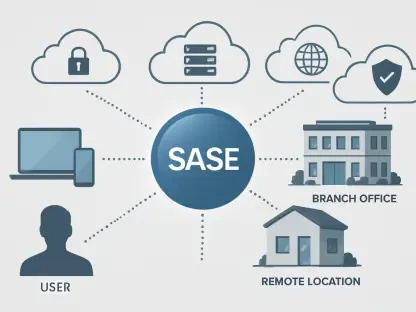In an era where digital transformation is no longer optional but essential for effective governance, the Texas Department of Information Resources (DIR) stands at the forefront of revolutionizing public sector IT through its innovative hybrid cloud strategies. Serving 121 state and local government entities, including educational institutions, DIR’s Data Center Services (DCS) program has emerged as a vital tool for modernizing outdated systems and enhancing service delivery across Texas. This initiative, rooted in a legislative push to streamline fragmented IT infrastructure, showcases a forward-thinking approach that balances technological advancement with practical governance. By integrating private and public cloud solutions, DIR not only addresses the diverse needs of agencies but also sets a benchmark for efficiency and adaptability in government operations.
The impact of this program extends beyond mere technology adoption, touching on core aspects of public service such as accessibility, cost management, and security. Agencies of varying sizes and missions now benefit from enterprise-level resources, ensuring that even smaller entities can keep pace with larger counterparts. As Texas continues to navigate the complexities of digital demands, DIR’s efforts provide a compelling model of how strategic cloud implementation can drive meaningful change in the public sector.
Hybrid Cloud Strategy and Benefits
Evolution and Structure of DIR’s DCS Program
The foundation of DIR’s transformative approach to IT services was laid in 2007, following a legislative mandate to consolidate over 30 disparate legacy data centers into two highly secure, redundant facilities. This bold move aimed to eliminate inefficiencies, reduce operational costs, and replace aging equipment with standardized, modern infrastructure. The DCS program, a key pillar of DIR’s Shared Technology Services, initially focused on private cloud and mainframe solutions, alongside ancillary services like print and mail operations. Over time, the program adapted to emerging trends, incorporating public cloud offerings by 2017 to complement its robust private cloud environment. This hybrid structure ensures that agencies can leverage the stability of private systems while tapping into the scalability of public platforms, creating a balanced ecosystem that prioritizes both security and innovation.
This evolution reflects DIR’s responsiveness to the changing landscape of technology and the specific needs of Texas government entities. By centralizing infrastructure, the program eliminated redundancies that once plagued state IT systems, paving the way for streamlined operations. The integration of public cloud services from major providers like Amazon Web Services (AWS), Microsoft Azure, Google Cloud, and Oracle Cloud further expanded options for agencies, allowing them to select environments best suited to their applications. With governance mechanisms in place to oversee this complex hybrid model, DIR ensures consistency and compliance, maintaining a high standard of service delivery across all participating entities. This structured yet adaptable framework has positioned the program as a leader in public sector IT modernization.
Flexibility and Choice in Cloud Solutions
A defining feature of DIR’s hybrid cloud model is the emphasis on choice, enabling agencies to avoid vendor lock-in and select platforms that align with their technical expertise or operational requirements. By offering access to multiple public cloud providers alongside private cloud options, DIR ensures that agencies—whether managing a staff of 12 or 35,000—can utilize the same cutting-edge tools. Texas CIO Amanda Crawford has highlighted this equity as a critical achievement, noting that smaller agencies with constrained budgets are no longer left behind in the race for digital advancement. This flexibility empowers entities to tailor their cloud strategies, whether prioritizing the control of private environments or the agility of public solutions, based on their unique mission demands.
Beyond technical choice, this approach fosters a sense of empowerment among agencies, allowing them to focus on core objectives without being tethered to a single provider’s ecosystem. The availability of diverse cloud options mitigates risks associated with dependency, ensuring continuity even if a provider faces disruptions. Additionally, DIR’s strategic partnerships with leading cloud vendors enable bulk pricing benefits, which are passed on to agencies, further enhancing affordability. This commitment to flexibility not only democratizes access to advanced technology but also builds resilience into Texas’s government IT landscape, preparing agencies for future challenges with a versatile and inclusive framework.
Impact on Agencies and Public Services
Cost Savings and Scalability
One of the most significant advantages of DIR’s cloud services lies in the cost efficiency achieved through a pay-as-you-go model and volume pricing agreements. Agencies can dynamically scale resources up or down based on demand, avoiding the hefty capital expenditures tied to traditional on-premises data centers. This financial flexibility is particularly beneficial for smaller entities that might otherwise struggle to fund large-scale IT upgrades. DIR further bolsters this advantage with strict financial controls, including spending thresholds and project approval processes, to prevent unexpected cost overruns in public cloud environments. Such measures ensure that budget management remains a priority, even as agencies embrace innovative solutions.
The scalability offered by DIR’s hybrid model also translates into operational agility, allowing agencies to respond swiftly to changing needs without overcommitting resources. For instance, during peak demand periods, additional cloud capacity can be provisioned quickly, ensuring uninterrupted service delivery. This adaptability reduces the risk of underutilized infrastructure, a common issue with fixed on-premises setups, and aligns spending with actual usage. By minimizing financial waste and maximizing resource efficiency, DIR’s approach not only saves taxpayer dollars but also enables agencies to redirect funds toward mission-critical initiatives, enhancing overall public value in Texas’s government operations.
Security and Risk Mitigation
Security remains a paramount concern in the adoption of cloud technologies, and DIR addresses this through standardized reference architectures that ensure consistent and compliant deployments across hybrid environments. These architectures provide a blueprint for agencies to follow, reducing variability and enhancing adherence to industry best practices. Additionally, a multisourcing services integrator oversees vendor performance and governance, ensuring accountability in both private and public cloud spaces. Regular health checks and proactive vulnerability management further minimize the risk of breaches, creating a fortified digital environment that agencies can trust for their sensitive data and operations.
This robust security framework has played a crucial role in alleviating initial hesitations among agency leaders about transitioning to public cloud platforms. By demonstrating a commitment to risk mitigation through structured oversight and continuous monitoring, DIR has built confidence in its hybrid model. The focus on compliance also ensures that agencies meet regulatory requirements, avoiding potential legal or operational setbacks. As a result, even entities handling highly sensitive information can adopt cloud solutions without compromising safety, knowing that DIR’s protective measures are in place to safeguard their systems against evolving threats in the digital landscape.
Digital Transformation Success Stories
The tangible benefits of DIR’s cloud initiatives shine through in the digital transformation achieved by agencies like the Texas Secretary of State’s Office. By migrating its 30-year-old Texas Register system to a cloud-native, low-code platform on AWS, the office slashed editorial preparation time by an impressive 75% and reduced security vulnerabilities by 70%. This overhaul not only modernized a critical public resource but also improved accessibility and efficiency for both staff and citizens. Such outcomes highlight how cloud adoption, facilitated by DIR, can breathe new life into legacy systems, turning outdated processes into streamlined, user-friendly services.
Another striking example from the same agency is the modernization of its Notary Public software, which achieved a 95% paperless filing rate and saved over 700 staff hours monthly. These results underscore the power of cloud solutions to drive operational efficiency and reduce manual workloads, allowing personnel to focus on higher-value tasks. The ripple effect of these transformations extends to the public, who benefit from faster, more reliable access to government services. DIR’s role in enabling such advancements demonstrates that cloud technology is not just a technical upgrade but a catalyst for meaningful improvement in how Texas agencies serve their communities.
Tailored Support for Diverse Missions
Across Texas’s vast governmental landscape, DIR’s hybrid cloud services cater to a wide array of agency missions, ensuring that entities like Texas Health and Human Services (HHS) can meet their unique needs effectively. HHS, supporting both the Texas Health and Human Services Commission and the Texas Department of State Health Services, utilizes a mix of private and public cloud resources—primarily AWS with some Azure—to optimize application performance. This tailored approach allows the agency to prioritize its core objectives, such as public health and welfare, while DIR manages the underlying IT infrastructure, reducing downtime and maintenance burdens.
The ability to customize cloud usage based on specific requirements is a game-changer for agencies with diverse operational scopes. Smaller entities, often constrained by limited IT staff, benefit from DIR’s hands-off maintenance model, which frees them to focus on service delivery rather than technical upkeep. This flexibility ensures that whether an agency is addressing public health crises or managing administrative records, it has the technological backbone to do so efficiently. DIR’s commitment to supporting varied missions reinforces its role as a vital partner in Texas governance, enabling every agency to leverage cloud power in a way that aligns with its distinct priorities and challenges.
Future Trends and Continuous Improvement
Rising Public Cloud Adoption
Looking toward the horizon, DIR anticipates a gradual shift in the balance of cloud usage, with public cloud adoption expected to grow toward a 50-50 split with private cloud over the next decade. Currently standing at a 70-30 ratio in favor of private environments, this projected change signals increasing confidence in public cloud capabilities among Texas agencies. The trend reflects a broader movement in government IT toward embracing public platforms for their agility and innovation potential, while still maintaining private cloud for sensitive or critical workloads that demand heightened control.
This cautious yet progressive approach to public cloud growth is underpinned by DIR’s focus on building trust through proven security measures and governance frameworks. As familiarity with public platforms increases, agencies are likely to explore more applications in these environments, especially for non-sensitive tasks that benefit from scalability. DIR’s strategic planning ensures that this transition is managed thoughtfully, avoiding rushed migrations that could expose vulnerabilities. By pacing the shift, DIR aims to sustain reliability and performance, positioning Texas agencies to capitalize on emerging cloud technologies without sacrificing stability in their IT operations.
Commitment to Customer Satisfaction
DIR’s dedication to client satisfaction is evident in its impressive 97% satisfaction rate recorded in fiscal 2024, a figure that at times reached 100% through focused relationship and change management efforts. This achievement stems from a proactive stance on understanding agency needs and addressing concerns swiftly, ensuring that the technology serves the user rather than the other way around. Continuous feedback loops and personalized support mechanisms are integral to maintaining this high standard, reflecting DIR’s belief that strong partnerships are as crucial as technical excellence in delivering value.
Beyond maintaining current satisfaction levels, DIR is committed to evolving its services to anticipate future demands and technological shifts. This forward-looking mindset involves regular assessments of agency experiences and adapting offerings to align with emerging priorities, whether related to cybersecurity, data analytics, or user accessibility. By fostering an environment of open communication and responsiveness, DIR ensures that agencies feel supported at every step of their cloud journey. This emphasis on customer-centric improvement solidifies DIR’s reputation as a trusted ally in navigating the complexities of modern government IT.
Industry Leadership and Broader Implications
Analysts have lauded DIR’s use of standardized reference architectures and hybrid cloud strategies as a blueprint for other states seeking to modernize public sector IT. By creating scalable, consistent implementations that reduce administrative burdens and enhance security, DIR has positioned Texas as a leader in governmental digital transformation. This recognition highlights the program’s alignment with broader industry trends, where hybrid models are increasingly seen as the optimal balance between innovation and risk management, offering a middle ground that addresses both agility and data sovereignty concerns.
The implications of DIR’s success extend beyond state borders, providing valuable lessons for public sector entities nationwide. The emphasis on avoiding vendor lock-in through multi-provider options and the focus on governance in cloud deployments offer a replicable model for balancing cost, security, and performance. As government IT continues to grapple with budget constraints and rising digital expectations, DIR’s approach demonstrates how strategic cloud adoption can yield sustainable benefits. This leadership role not only elevates Texas’s standing but also contributes to a collective push toward more efficient, citizen-focused government services across the country.









